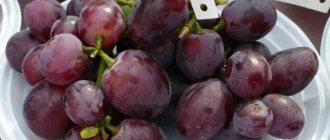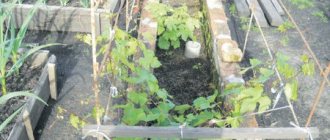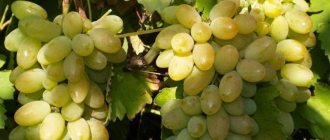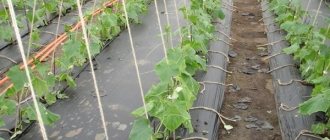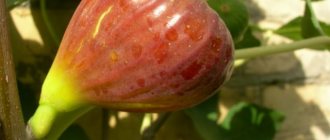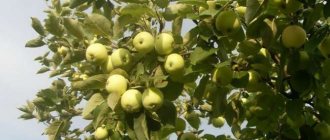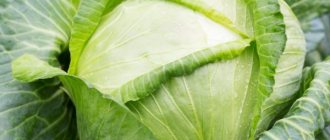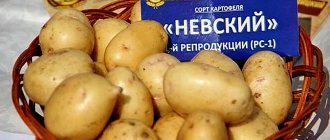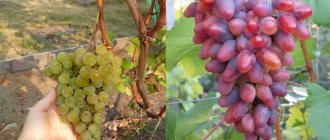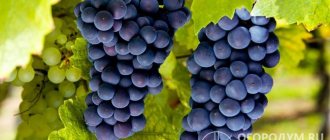Advantages and disadvantages
| Strengths | Weak sides |
|
|
Origin
“Flora” is the result of the work of Ukrainian breeders from the Institute of Viticulture and Winemaking named after V.E. Tairov, located in Odessa. At the first stage of creation, scientists used three varieties of the crop - “Muscat de Saint-Valier”, “Hussaine” and “Hamburg Muscat”.
Parents of “Laura” are “Muscat de Saint-Valier” and “Hussaine”
On the second, the resulting hybrid was crossed with the “Queen of Tairov” species. As a result, the new plant inherited the best characteristics of its parents: excellent taste, transportability and resistance to fungal diseases.
Reproduction
To get a new plant, you can grow a seedling by cuttings or graft a shoot onto an old bush. The first option involves germinating roots directly on the shoot:
- The cuttings are buried 20 cm into the soil.
- After the roots have formed, it is cut off and placed in a permanent place.
The second propagation option involves grafting cuttings onto any grape variety. First, the cut young vine is placed in a container with warm water, where it is kept for 1 hour. And then the cut is treated with a solution based on Humate and introduced into the cut of the rootstock.
An unpretentious, frost-resistant and promising grape variety, Laura deserves to be in the collection of every gardener. By performing simple agricultural techniques, it is possible to obtain quite decent results.
Laura or Flora grapes are one of the most favorite table varieties, which are distinguished by high yields and a wonderful taste of berries with a slight hint of nutmeg.
The exceptional properties of the variety are a fairly long shelf life after harvest, good transportability and long-term storage directly on the bushes.
Main characteristics
Thanks to its characteristics, “lora” has gained great popularity among gardeners. The variety is readily grown throughout almost the entire territory of Russia - it is early ripening, frost-resistant and capable of producing large yields. It is also worth noting such varieties as “Lily of the Valley”, “Sofia” and “Kodryanka”.
Ripening period
The ripening period of berries varies from 110 to 115 days. Flowering usually begins in May, and by mid-August the bushes are already producing their first harvest. This period is maintained provided that the plants are not overloaded, otherwise the harvest of fruits may be delayed by several weeks.
Reference! The sweetness of the crop may be reduced by high humidity, cool weather and tall rootstocks.
Bush
The bushes are strong, of medium height, grow quickly and begin to bear fruit at 2-3 years of age in the southern regions, at 5-6 years in the middle zone. They have a flexible light brown trunk with grayish inclusions. Young shoots are also brownish, but with a reddish tint. The volume of fruiting vines is 60-80%.
The leaves are large, smooth, palmate-lobed with serrated edges. Their color range ranges from light green to rich emerald.
The inflorescences of the “flora” are unisexual (female), so they need pollinators. To do this, you can use such varieties of grapes as: “Rusbol”, “Arcadia”, “Kishmish radiant”, etc.
Important! It is recommended to form bushes on a trellis or other support (fence, arch, fence, column, etc.) - they need to climb along something.
Bunches
The “lora” clusters are cylindrical-conical in shape and approximately the same size, which makes the variety attractive for growing for sale. The average length of the brush is 35-40 cm. Moreover, its weight can vary from 600 g to 2.5 kg.
The density of the berries in the bunch is loose or medium. The brushes can remain on the vine until frost, but they do not lose their presentation or fall off.
If, during rationing, an insufficient number of bunches are left on the bush, the berries will begin to increase in size. At the same time, the period of fruit ripening will be reduced. However, it is better not to allow this - as a result of ripening too early, the plant may sprout new shoots, which will lead to its depletion before winter and increase the risk of death of the vineyard.
Berries and taste
There are berries of oval, cylindrical and oblong shape, their parameters are:
- Length - 3-4 cm.
- Width - 2-2.5 cm.
- Weight - 8-10 g.
The fruits are painted a beautiful milky white color with a light light green tint. At the same time, berries located on the south side have the ability to “sunbathe” - turn slightly yellow in the sun.
The skin is thin, tender and cannot be felt during consumption; it is covered with a waxy coating. The pulp is juicy, dense and slightly crunches when bitten. There are 2-3 grains, they are quite large and hard, but easily separated.
Reference! You can get rid of seeds by treating Laura with gibberellin (a growth regulator).
The fruits are sickly sweet, sometimes with a slight sourness, and have a barely noticeable aroma of nutmeg. Their taste is balanced due to the high sugar content - 20% and low acidity - 6-8 g/l.
Due to the quality of the berries, “flora” is considered a universal variety - it is used to make dessert wines, juices and compotes, and is also consumed fresh.
Productivity
The yield of the bushes is high, but not constant: in one year a lot of berries are produced, in another - few. However, with proper cultivation, 35-45 kg of fruit can be obtained from a bush. The indicator directly depends on climatic conditions: the more sun, the higher it is.
Comparison with analogues
Let's compare the “flora” with the varieties most similar to it.
| Sign | Variety | |||
| Laura | Kishmish No. 342 (Hungarian) | Julian | Super extra | |
| Ripening period | 110-115 days | 110 – 115 days | 100 days | 95-105 days |
| Frost resistance | up to -26°С | -26C | Up to -23 °C | Up to -25 °C |
| Yield per bush | up to 45 kg | 20 kg | 30-60 kg | Up to 25 kg |
| Bunches | up to 2.5 kg | 300 – 500 g | From 800 g to 1.5 kg | 500-800 g |
| Taste | sickly sweet, sometimes slightly sour | Nutmeg flavor | Sweet with notes of nutmeg and strawberries | Simple, moderately sweet |
| Color | milky white with a light green tint | Green-golden | Light pink with a yellowish tint | Green-yellow with amber tint |
| Disease resistance | average | High | High | Average |
| Shelf life | up to 4 months | 1 month | 1-2 months | A few months |
| Sugar content | 18-20% | 19-21% | 28% | 17,40% |
| Acidity | 6-8 g/l | 6-8 g/l | 4-5 g/l | 6.1 g/l |
Growing and care
“Lora” is a variety whose properties strongly depend on the region of cultivation, the correct choice of planting site and the quality of care provided for the bushes.
Planting and soil
In the southern regions, “lora” is planted from October to March , in the middle zone and northern regions - in early spring, after the air temperature is about 16-17ºC, and the soil temperature is 10-12ºC.
The optimal location for growing the variety will be a sunny, elevated area. If you plan to plant a vineyard on a slope, then preference should be given to its southern side. It is also important to pay attention to the depth of groundwater - it should not come close to the surface. You can learn about the ideal place for grapes in a separate article.
Reference! Protection from wind and drafts - nearby walls of outbuildings or a dense crown of trees growing nearby - will have a positive effect on the yield of the plant.
To plant bushes, you can use any light, non-salty soil: black soil, sandy loam, loam, etc. The wells should be prepared in advance - about 2-3 weeks:
- Dig planting holes 80x80x80 cm, so that the distance between them is at least 1.5 m, between the rows - more than 2 m.
- Spread some organic fertilizer on the bottom.
- Sprinkle with substrate.
- Leave for at least 15 days, water once a week.
Seedlings also need preliminary preparation:
- One day before planting, place young plants in water.
- After 24 hours, trim the roots slightly, leaving the strongest and healthiest ones.
- Start planting.
Planting “lora”
During the procedure, you should place the plant in the center of the hole, carefully straighten the root system and sprinkle it with earth. After which the soil must be compacted, watered abundantly (2-3 buckets of water for each bush) and mulched with sawdust, straw or hay.
Reference! Humus cannot be used for mulching - it harbors insect pests and pathogenic organisms.
A young shoot definitely needs support, so it is recommended to immediately install a wooden peg next to it and tie the plant to it with a soft rope.
Watering and fertilizing
“Laura” requires regular watering. The only exceptions are periods when there is high humidity and rainy weather.
It is advisable to apply water under the bush; for this, several holes should be made around the plant (about half a meter from the trunk), 25-30 cm deep, and watered through them. This is due to the fact that moisture is not absorbed by the roots in the stem area.
Water standards per day:
- Young bush - 3 l.
- Adult - 6 liters.
The main thing is not to water the plants during the period of flower formation and ripening of berries, otherwise the harvest will suffer. It is preferable to carry out the procedure in the evening hours. After watering, the holes must be covered with earth.
Grapes also need fertilizing:
- In early spring, before the snow melts.
- In May - during the swelling of the buds.
- At the beginning of June - before flowering (2-3 weeks).
- In mid-July to early August - at the beginning of fruit ripening.
You can use both organic and mineral fertilizers.
Trimming
For the first 1-2 years, the “flora” bushes should not be trimmed. After the expiration of the period, the procedure should be carried out every autumn. At this time it is necessary:
- Remove old, weak, damaged and diseased vines.
- Thin out shoots that are too dense.
You should leave 3-4 main branches, which will gradually thicken and grow. It is not recommended to get too carried away with pruning - the variety reacts negatively to it: the vines may stop bearing fruit.
Trimming can be:
- Medium - 5-6 eyes.
- Short - 2-3 eyes.
“Laura” also needs to ration the bunches. It is important not to leave more than 50 clusters per bush, but even with this number there is a chance that the berries will begin to shrink. Therefore, it is better to stick to the optimal value of 24-28 pcs.
Attention! During the procedure, it is important to additionally regulate the number of eyes; on an adult bush there should be no more than 30-40 of them.
The number of leaves should also be controlled: during ripening, the fruits need a lot of sun, so the formation of shadows over them should not be allowed.
In order for the bushes to develop correctly, they need to be tied up. The vines should be fixed to the trellis at an angle of 45º or horizontally, otherwise the shoots will grow only from the upper buds.
It is preferable to form the plant in the shape of a fan.
Frost resistance and wintering
“Flora” has fairly high winter hardiness - the variety can withstand frosts down to -26ºС. However, during the cold period of the year, its bushes need shelter, provided that in the growing region the winter temperature drops below -15ºС.
Activities should begin closer to the first days of October, when the indicator value is set at 5-8 degrees below zero. 2 weeks before this, the plant must be watered generously with warm water at the rate of 20 liters per bush.
Preparing bushes for cold weather includes:
- Pruning.
- Treatment for parasites and diseases.
- Mulching the root zone.
- Removing the vines from the support.
You can protect grapes from frost using:
- Greenhouses are a preferable option if the number of bushes is small. In this case, the grapes are laid on the ground, covered with spruce branches or sawdust, and then greenhouse arcs are installed above them, which are covered with film. It is important to leave small gaps for ventilation.
- Huts - lay out the vines on the ground, cover with burlap, sawdust or straw. Place pieces of slate over the plants in a “house” and secure the structure with heavy objects (bricks, boards, etc.) or an earthen embankment.
- Embankments - lower the shoots to the surface of the soil, wrap them in burlap, straw, agrofibre or sawdust and cover them with a layer of about 25-30 cm of soil on top.
In spring, the time for opening grapes depends on the region: in the southern regions the procedure can be carried out from mid-April, in the northern regions - in the 2-3rd week of May.
It is recommended to do this gradually: first (10-14 days in advance), the “lore” should be opened and cleared of debris and soil. Then you need to leave the bushes in the fresh air during the day, and cover them well again at night.
Storage
It is advisable to collect the “flora” berries as they ripen, however, if processing is impossible for some reason, it is permissible to leave the bunches on the bushes for a while. Their quality will not suffer from this. However, you should not delay, otherwise the fruits will begin to wilt. Freshly picked berries can be stored for about 4 months.
Regions
Due to its early ripening period, the variety is suitable for cultivation in almost all regions of Russia. The only exceptions are the northern regions. However, the bushes develop and bear fruit best in warm parts of the country, where they have enough sun.
Hybrid propagation
The Laura grape variety is not particularly demanding in terms of living conditions. But in order to ensure a harvest of high-quality fruits, loose soils located at a certain height should be chosen for seedlings. Not all grapes like a large amount of groundwater. If the situation requires it, drainage is installed.
A mandatory requirement for optimal development is warm weather and light. This will accumulate strength for fruit formation. Species located along the fence or wall of the house take root well. In inclement weather, they can be additionally warmed by protecting them from drafts. The area for planting is selected with minimal draft penetration.
If there are fruit trees in the neighborhood, planting grape crops ensures optimal light intake while minimizing the passage of winds. Reproduction is carried out using two methods:
In the second case, a hole is built for planting material, placing fertilizer in fertile soil.
To ensure that the crop develops well and does not infringe on nearby bushes, a distance of at least 1.2 m is provided between them. When growing along a fence or wall of a residential building, you need to move one and a half meters away from them. This ensures optimal supply of air and nutritional compounds. The seedlings are not moved into the holes immediately, but by the end of the second week.
During this period, the soil must be moistened. Determine the amount of water visually. There should not be significant moisture. Sprinkle the roots of the cuttings with soil, mixing with mineral fertilizer. Seedlings are prepared for subsequent planting in accordance with the diagram.
They grow roots in water. To do this, immerse the shoot 20 cm into the substrate. After the formation of strong roots, the young bush is moved to a new location.
Next, check out the photo of the variety, its beneficial properties and reviews about it.
Photo
Beneficial features
Grape fruits contain a huge amount of vitamins, useful chemical elements, flavonoids, organic acids, as well as fructose, glucose and fiber. Therefore, they are widely used for the prevention and treatment of pathologies of the cardiovascular, digestive, nervous, endocrine, reproductive and respiratory systems. Berries also have a positive effect on immunity and brain function. The leaves and seeds of the plant are used in cooking, medicine and cosmetology.
Reviews
In the 4th year, Laura’s harvest turned out to be excellent. Very good taste and high transportability. In general, not a variety, but a miracle. There are just years when Laura is very upset. Very sensitive to overload. Disease resistance is at the level of Arcadia. An excellent variety for both the market and the family. Vitaly, Uzhgorod
Laura is a super variety; I don’t know the best white-berry varieties from the early and very early varieties except Laura and Arcadia. Roman, Krivy Rog
Even beginners can grow Laura and they simply fly away at the market, it’s so delicious. Nadezhda Nikolaevna, Krivoy Rog
The clusters are beautiful, not dense, not pea-shaped. The berries are tasty, dense and crunchy. One of the best varieties. Anatoly, Dnepr
History of variety selection
This grape variety is a hybrid. It was bred in Odessa by crossing several species and absorbed all the best qualities of its ancestors. The following famous cultures were used to create Laura:
- Muscat de Sant Valle;
- Husayn;
- Muscat of Hamburg;
- Queen Tairovskaya;
- Kober 5BB.
For a long time the variety was known under the name Laura. In 2011, it was included in the State Register of Russia under the name Flora. However, many gardeners call it Laura out of habit.
